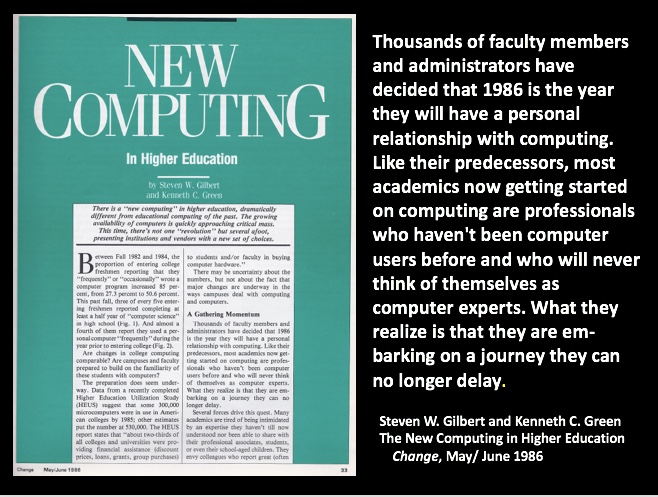You have /5 articles left.
Sign up for a free account or log in.
Last week in Inside Higher Ed, reporter David Matthews of The Times Higher Education characterized “as a surprising conclusion” the work of Carnegie Mellon University anthropologist Lauren Herckis that a major barrier to instructional innovation and technology utilization in higher education is that faculty “are simply too afraid of looking stupid in front of their students to try something new.”
Alas, this is not a new news. Nor is it a surprising conclusion. The fear of trying among faculty, because of the fear of looking awkward, foolish, or incompetent in front of their students, dates back to the arrival of the first microcomputers (aka IBM PCs and Macs) in college classrooms and campus computer labs in the mid-1980s.
Let us review the reasons why the fear of trying is neither new nor surprising.
More than three decades ago the core technology skills we now view as essential and today we hope are ubiquitous among students and faculty typically were not. Typing, transformed as keyboarding, emerged as a critical skill. In the early-1980s, I attended an interesting presentation on the future of office automation. The speaker, a technology expert from Rand Corp., explained the semantic imperative for talking about keyboarding: typing was a (low status) secretarial skill, while keyboarding implied a higher status skill tied to computers. The semantic rebranding of typing as keyboarding, the Rand expert explained, would make learning keyboarding (aka typing) more acceptable to mid- and high-level managers and professionals.
Concurrent with keyboarding was, of course, learning to use and master key computer applications such as word processing, spreadsheets, and presentation software. Understandably this was a time-intensive and often frustrating task for many mid-career faculty some 25-35 years ago, despite the best efforts of their institutions to provide faculty only training programs and one-on-one instruction (alas, often provided by tech-savvy undergraduates).
But even as faculty began to acquire these core tech skills, other fear of trying factors emerged. For example, by the early/mid-1990s, I began hearing reports of what I would come to characterize as a new form of “Oedipal aggression in the classroom.” Beyond mocking professors for their academic demeanor or attire, students could now chastise faculty for their discomfort with technology:
- One dimension of the tech discomfort was when faculty would have to type (or rather, keyboard!) in front of their students. When fumbling keyboarding efforts were projected onto a classroom screen, faculty often confronted the stage whispered comment that “Oh look! Professor Jones can’t type.”
- Internet access to primarily sources – including faculty authors at other institutions – emerged as the second dimension of public professorial discomfort. If Prof. Jones was not available to discuss an assigned reading, students could easily email their questions directly to Prof Wilson, author of the assigned article. And, in turn, Prof. Wilson might respond with more than just answers, perhaps asking to see the syllabus that included his or her work.
- A third dimension of the public professorial discomfort emerged as classrooms went wireless, enabling students to easily fact check faculty in real time: “Prof. Green: your data are interesting, but dated. I’m looking at the most recent numbers from the same source you used, and things have changed a bit.”
Beyond the public potential for embarrassment, one continuing factor in the conversation about innovation and the fear of trying has been the absence of compelling evidence that a new technology or innovative instructional technique really does make a difference in student learning and outcomes. Four decades into the much discussed (and hyped!) “IT revolution” in higher education, a good portion of the campus conversation about innovation and technology remains driven by opinion and epiphany, rather than hard evidence documenting impacts and outcomes. Consequently, it is not surprising that many faculty would understandably be ambivalent about “attempting to innovate” in their instructional activities if there is no evidence that “innovation” affects student learning and outcomes.
Finally, there is the continuing absence of collegial, departmental, and institutional recognition and reward for innovation also affects the fear of trying. Data from The Campus Computing Project confirm that the vast majority of the two-and four-year American colleges and universities have not expanded the algorithm for review and promotion to include faculty efforts at instructional innovation and technology. So despite the public proclamations of presidents and provosts about the “key role of innovative information technology resources here at Acme College,” review and promotion decisions reside in the hands of departmental colleagues and chairs who have largely been unwilling adopt an expanded notion of scholarship for their (often younger) colleagues who would like to pursue innovation in their instructional activities.
If trustees, presidents, provosts, deans, and department chairs really want to address the fear of trying and foster innovation in instruction, then they have to recognize that infrastructure fosters innovation. And infrastructure, in the context of technology and instruction, involves more than just computer hardware, software, digital projectors in classrooms, learning management systems, and campus web sites. The technology is actually the easy part. The real challenges involve a commitment to research about the impact of innovation in instruction, and recognition and reward for those faculty who would like to pursue innovation in their instructional activities.



